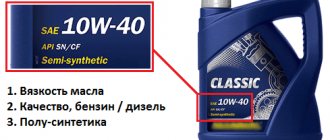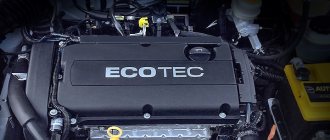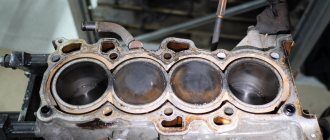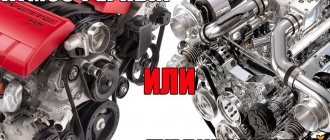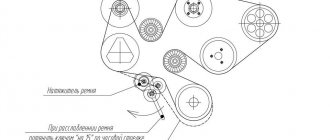The Chevrolet Aveo is a subcompact car, produced by General Motors since 2002. The second generation model has been produced since 2011. The Chevrolet Aveo is assembled in Kaliningrad, where for the Russian market the car is equipped with a 1.6-liter 115-horsepower ECOTEC engine. The first generation model is listed in catalogs under different indexes – T200 and T250. From a technical point of view, the T200 and T250 cars are the same, but the 2008 restyling brought a new body type - a three-door hatchback. New trim levels have also become available to customers - LS, LT and LTZ. Under license, the Aveo model was also produced at other car factories under other names ZAZ Vida and Ravon Nexia. The car is quite popular to this day due to its low cost and affordable maintenance. In this article we will tell you what the service life of the Chevrolet Aveo engine is.
Line of Chevrolet Aveo engines
Initially, the Chevrolet Aveo was presented to the buyer in the back of a T200 and was equipped with a 1.2 and 1.4 liter gasoline engine. In Europe, the car was sold with a 1.6-liter power unit with 109 horsepower (after restyling) and a 1.5-liter gasoline engine in the pre-restyling version, its power was 85 horsepower. With the release of the second generation, the working engines remained the same, but the range of power units itself has undergone major changes. Their power was increased and brought to compliance with current environmental standards.
Line of Chevrolet Aveo power units:
- F14S3 – 1.4-liter gasoline engine developing 83 horsepower;
- F14D3 is an engine with a displacement of 1.4 liters, but with 94 horsepower;
- F15S3 – 85-horsepower power unit, paired with a manual gearbox;
- F12S3 – 1.2-liter gasoline engine with a nominal power rating of 72 horsepower;
- B12S1, F12S3, LY4 – 1.2-liter 72-horsepower engine;
- LMU – 1.2 liter engine, 84 horsepower;
- F14D4 – 101-horsepower version of the previous engine;
- F16D3 – 1.6-liter engine with 109 horsepower;
- A12XER – gasoline engine with a displacement of 1.2 liters;
- A14XER – 1.4-liter gasoline engine with 100 horsepower;
- A12XEL – 1.2-liter 70-horsepower engine;
- LDV – 75 horsepower diesel engine with a displacement of 1.2 liters;
- LSF – 95-horsepower 1.2-liter diesel engine;
- F16D4 – another 1.6-liter engine, but with 116 “horses”;
- L95 (another designation F14D3) is a 1.4-liter internal combustion engine, which was equipped with cars for the Russian market.
As you can see, the car was equipped with various engines, mainly gasoline, but there are also a couple of diesel power units. But, as for Russian operating conditions, domestic motorists had the opportunity to purchase a new car only with a gasoline internal combustion engine, since the diesel version was intended only for the European market.
Right choice
Over the 13 years of its presence on the European and Russian markets, Chevrolet Aveo has offered several generations and vehicle configurations. Practice has shown that the domestic buyer is very selective when it comes to power plants. The question of choosing the right unit depends on the driver’s expectations in terms of both performance and cost of the car.
It is best to buy a used Aveo of the first generation with a 1.4-liter engine. The unit is not subject to serious wear, unlike the 1.6 MT and AT versions, which show themselves to be less reliable over a long period of time. Despite all the shortcomings of the 1.2-liter engine, in a used car it will hardly perform noticeably worse than a new one. At the same time, the cost of the car will be very pleasant. These power plants are inexpensive to maintain, although due to the gradual disappearance of outdated components from the market, finding the necessary parts is becoming more difficult every year.
With restyled versions the picture is more rosy. You can purchase both 1.4 and 1.6 liter versions, while the latter should be considered from 2010 to avoid problems with increased wear. It is not recommended to purchase a “one and a half” engine, since even in new cars it has not shown itself to be very stable. Owners give excellent recommendations to the 1.2-liter engine. Improved engine architecture and excellent interaction with the transmission system are an excellent reason to take a closer look at the economical unit.
The purchase of second-generation used cars depends in most cases only on the care of the previous owner and his compliance with the requirements for technical inspection and operation. Of course, there is no need to buy a 1.2 MT if there are 1.4 and 1.6 liter versions. If you have enough money, it is best to take a closer look at the last of the proposed variations.
The new 2021 Aveos only come with 1.6-liter engines. Regardless of the functional configuration (LT or LTZ), the power units are identical, so for the buyer the question will be to choose between a manual and an automatic. In this case, the question, as a rule, is not posed from the perspective of fuel consumption: the decision depends only on habit and ease of use.
F14S3
The structurally simple 1.4-liter F14S3 engine was installed in the Chevrolet Aveo in Europe. Its maximum power is 85 hp, and the torque reaches 132 Nm when reaching 3000 crankshaft revolutions per minute. The architecture is conventional - inline four with an 8-valve SOHC cylinder head.
The piston stroke in this engine is 81.5 mm, the cylinders are bored to 77.9 mm. Quite reliable and economical engine (consumption about 7 liters per hundred). With timely maintenance, it runs over 200 thousand kilometers before the first major overhaul.
F14D3
This 1.4-liter engine was assembled in South Korea from 2002 to 2008 and installed in mass-produced General Motors cars, which include the Chevrolet Aveo. In Russia, a car with such an engine could also be purchased, but the internal combustion engine was labeled differently - L95. That is, F14D3 and L95 are two identical 1.4-liter gasoline engines developing 94 horsepower at their peak. Equipped with a distributor fuel injection system, capable of producing 130 Nm of torque. Made of cast iron (cylinder block), aluminum cylinder head, 16-valve. The cylinder diameter in the F14D3 (L95) is 77.9 mm and the piston stroke is 73.4 mm. The timing mechanism uses a belt to drive it.
It has hydraulic compensators, so the driver does not need to adjust the thermal clearances. Among the features, we can note the presence of a system for changing the intake geometry VGIS. In general, the engine is reliable and not capricious, but the service life of the Chevrolet Aveo 1.4 engine does not exceed 250 thousand km. One of the main disadvantages of the engine is the tendency to form carbon deposits, as a result of which the valves begin to hang. Many motorists who were or are associated with this modification of the car point to an insufficiently reliable valve cover: engine oil begins to leak, spark plug wells are filled. Note that in a car with such an engine it is necessary to change the timing belt at least once every 50-60 thousand km. It does not serve longer, and if it breaks, it leads to a collision of pistons with valves.
Timing device Chevrolet Aveo 1.4 liters
There are a number of important points in the Aveo 1.4 timing drive. Firstly, there is no longer a pump involved in the belt drive. The coolant pump rotates on a separate belt, together with the generator. Although on the old version of the F14D3 engine the pump pulley not only rotated due to the timing belt, it also served as a tensioner for the entire drive. Moreover, now the timing belt needs to be replaced once every 150 thousand mileage! The Aveo 1.4 timing diagram is in the next photo.
Chevrolet Aveo 1.4 liter engine characteristics
- Working volume – 1399 cm3
- Number of cylinders – 4
- Number of valves – 16
- Cylinder diameter – 77.9 mm
- Piston stroke – 73.4 mm
- Timing drive - belt (DOHC)
- Power hp (kW) – 101 (74) at 6400 rpm. per minute
- Torque – 131 Nm at 4200 rpm. per minute
- Maximum speed – 165 km/h
- Acceleration to the first hundred – 13.1 seconds
- Fuel type – gasoline AI-95
- Compression ratio – 10.5
- Fuel consumption in the city – 8.6 liters
- Fuel consumption on the highway – 5.1 liters
- Fuel consumption in the combined cycle – 6.4 liters
In our country, the Aveo with this engine was combined with both a 5-speed manual transmission and a 4-speed automatic transmission.
F15S3
The 1.5 liter engine was assembled until 2011, installed on the Aveo in the back of the T200 and T250, as well as under the hood of the Chevrolet Lanos T150. In terms of design, it is even simpler than the previous engine, since there is no VGIS, which often brings unnecessary trouble. Its design is standard - a “four” made of cast iron, installed in a row, on top of which is an aluminum 8-valve cylinder head. The engine received distributed fuel injection and is capable of producing 86 horsepower. Peak torque is 130 Nm. A single camshaft drives the belt. Its service life is on average 50-60 thousand km; if it breaks, the valve bends.
The engine is very good, and the main problems with it are related to the electronics. Problems with engine operation may begin due to wiring problems or due to the failure of one of the sensors. Since the F15S3 is equipped with hydraulic compensators, there is no need to skimp during maintenance. It is best to purchase branded motor oils with the viscosity recommended by the manufacturer. If you deviate from the recommendations, the hydraulic compensators will quickly knock. On specialized forums, the causes of all kinds of engine oil leaks are often discussed, as well as comprehensive measures to prevent them. In general, if you do not skimp on maintenance, the service life of the F15S3 engine will be 300 thousand km, but there are examples of cars that have traveled even 350 thousand km without major repairs. But these are already exceptions.
Dismantling process
To begin with, you should understand that changing the engine on a Chevrolet Aveo is quite problematic, and you will have to spend a lot of time. What tools will you need? We collect all kinds of keys and heads, a hammer, a crowbar, a hoist, and pliers. It is worth understanding that this process will require a day, or maybe two, in order to dismantle the Chevrolet Aveo engine. Let's begin the process of considering the dismantling of the Chevrolet Aveo engine:
- First of all, I dismantle the minus and plus terminals and remove the battery.
- Next, you need to remove the fuel pump fuse.
- Then we relieve the fuel pressure that enters the engine.
- To carry out the process, you will need to remove the hood assembly from the car.
- Now you need to drain all the engine fluids. First of all, drain the engine oil, and then the coolant.
- Next, you need to remove the negative battery cable from the car frame.
- It will also be necessary to drain the working fluid, if any, from the air conditioner.
- Next, you need to disconnect the temperature sensor wiring and remove the temperature sensor.
- We find all the cooling system pipes that fit into the engine. Unclench the clamps and remove them.
- The crankcase ventilation tube must be disconnected from the valve cover.
- Remove the front right wheel.
- You also need to remove the front fender liner.
- The next step will be to dismantle the drive belts of the auxiliary options.
- Now you need to remove the fan along with the radiator of the cooling system. For easier and more accessible dismantling, it is recommended to remove the front bumper.
- Now you need to remove the expansion tank. To do this, unscrew all the mounting bolts and remove the coolant supply pipe.
- The next step will be to remove the power steering, namely draining the fluid and removing the pump itself.
- Now you need to remove the ignition coils.
- It is worth understanding that you will also have to remove the grounding.
- Now disconnect the oxygen sensor wire connector.
- Where do we install the fuel injector wiring?
- Remove the throttle position wiring.
- Connect the knock sensor wiring.
- Disconnect the generator wiring. It is necessary to disconnect the voltage regulator wires.
- Disconnect the fuel lines from the fuel manifold.
- Disconnect the throttle valve cable. After this, you need to remove the intake manifold bracket.
- Disconnect the camshaft position sensor wiring.
- When disconnected, remove the heater pressure hose.
- Remove the heater exhaust hose.
- Disconnect the wire marked “S” on the starter.
- Unscrew and disconnect the air conditioning compressor hose.
- Disconnect the wiring from the compressor coil.
- Unscrew and remove the air conditioning compressor.
- Now you need to remove the air conditioning compressor elements.
- Next, you should remove the fastening elements of the catalyst to the exhaust manifold.
- We go to the bottom of the car and unscrew the exhaust pipe muffler nuts. We remove the exhaust pipe.
- Now, you need to unscrew and remove the crankshaft pulley.
- The next step is to disconnect the wiring harness from the oil pressure valve.
- Now you can remove the crankshaft position sensor.
- Since the battery has been removed, the battery shelf now needs to be removed.
- We unscrew the gearbox mounts, essentially the pillow.
- Disconnect the wiring of the auxiliary switch.
- Next, you need to remove the hydraulic clutch tubes.
- After the box is released, you need to lift it.
- Using a hoist, we hook and lift the engine.
- We remove the motor from the cushions.
- After the engine is freed from the box, lift the power unit up and remove it from the car.
- The next step will be to repair or replace the engine.
- Assembly of this element is carried out in the reverse order.
- Do not forget that there is a tightening torque for any engine threaded connections. So the tightening element for a gearbox with a 75 Nm motor.
This is one of the easiest options for removing the engine from a car yourself.
B12S1, F12S3, LY4
The 1.2-liter B12S1 engine is also designated F12S3 and LY4. Its assembly took place in South Korea, and the internal combustion engine was intended primarily for cars in the budget segment. When the engine spins up to 4400 rpm, it produces 104 Nm of torque. The diameter of its cylinders is 68.5 mm, the piston stroke is 78 mm. A fairly simple power unit, consisting of four cylinders and an 8-valve cylinder head. The timing drive consists of one SOHC camshaft and a belt. The engine consumes about 6.6 liters of fuel per hundred kilometers in the combined cycle.
The engine does not have any design features: there are no hydraulic compensators, no phase regulator and no turbine. There are known cases of a motor reaching a service life of 250 thousand kilometers without a single major repair, although in practice this does not happen often. Due to clogging of the engine oil supply nozzle, the cams wear out quickly along with the camshaft bed. The problem is solved by drilling out the nozzle. The timing belt is quite reliable - it “lives” 90-100 thousand km, but it is best to change it after 70 thousand km, since if it breaks, it will bend the valves. Since there are no hydraulic compensators, the driver’s task is to adjust the thermal clearances every 50-60 thousand km to prevent serious damage.
L.M.U.
Until 2015, the 1.2-liter LMU gasoline engine was assembled at General Motors factories. It was installed not only on the Aveo, but also on the Chevrolet Spark. The engine received several modifications, which are not particularly different from each other. This engine is equipped with a distributor fuel injection system and develops 84 horsepower and 114 Nm of torque. Cast iron 4-cylinder in-line cylinder block and 16-valve cylinder head. Instead of a timing belt, it uses a chain. The diameter of the “boilers” is 69.7 mm, and the piston stroke is 79 mm. The engine is equipped with a variable intake geometry system VGIS.
We can say that this is one of the most reliable power units from the car’s internal combustion engine line. Particularly pleasing is the fact that a sedan with such an engine can be purchased in Russia. There are plenty of good offers on the secondary market. The main headache occurs due to constant leaks of engine oil and problems with attachments. Also, do not forget about the need to adjust the thermal gaps. In the LMU engine, this technical measure can be performed every 100 thousand km. This engine has few disadvantages, and its potential resource is 300 thousand km. The advantages include a reliable chain drive of the gas distribution mechanism. Capable of traveling 125-150 thousand km.
F14D4
The F14D4 engine, which belongs to the ECOTEC family, is actually an upgraded version of the F14D3 from the ETEC II family. The first thing that should be noted among the innovations is the presence of phase regulators at the inlet and outlet. Individual ignition coils and an electronic throttle valve appeared, the service life of the timing belt was improved, and the USR system was eliminated. As a result of modernization, the engine power increased to 101 “horses”, which is quite good for a 1.4-liter gasoline engine. The architecture remains unchanged - the cylinder diameter is the same, as is the piston stroke. The engine is made of cast iron (block) and aluminum (cylinder head). The head here is 16-valve. However, it was not without its drawbacks.
Firstly, the emerging system for changing valve timing often malfunctions, namely, the solenoid valve of the phase regulator fails. You can understand the problem by the operation of the engine, which is similar to the operation of a diesel unit. This problem can be eliminated by cleaning the valve, but this does not always solve the problem. Often the valve itself has to be replaced. Thermal clearances in the F14D4 motor are adjusted by selecting calibrated glasses. You shouldn’t delay maintenance, and you need to adjust the valves at least every 100 thousand kilometers. Like many other GM engines, this engine is characterized by a weak and unreliable thermostat. There is nothing else to reproach this motor for. The resource can be 250 or 300 thousand km. Much depends on the current operating conditions of the car.
F16D3
This 1.6-liter engine was assembled until 2013. We placed bets on the group's most popular cars, including Aveo, Cruze and Laccheti. Its design is simple and does not raise any questions - an in-line “four” with an aluminum 16-valve cylinder head. The piston travels 81.5 mm, and the cylinder diameter is 79 mm. At peak, the engine produces 109 horsepower and 150 Nm of torque. There are hydraulic compensators and an intake system with variable geometry.
In fact, all the problems and shortcomings inherent in the F14D3 can be classified as the disadvantages of this engine - valves hang, the belt breaks after 60 thousand km and the valve bends, deposits actively form in the injectors, which causes the internal combustion engine to triple. High-voltage wires and a water pump do not last longer than 100 thousand km, and traditionally for engines from this concern there is also a thermostat. However, if you pour good oil and high-quality AI-92 gasoline, then it is quite possible to prevent many difficulties, and then the service life of the Chevrolet Aveo engine will be 300 thousand kilometers.
Engine Chevrolet Aveo T250 1.6 liters
This engine is essentially an upgraded version of the Daewoo A16DMS engine and also belongs to the GM E-TEC II series. The head here is sixteen-valve with hydraulic compensators and a system of variable intake geometry. Timing belt drive with a service life of about 60,000 km.
Most of the problems of this power unit are caused by endless lubricant leaks. Oil often gets into the spark plug wells, which very often leads to ignition failures. The remaining breakdowns of this engine are usually associated with increased carbon formation, which not only clogs the fuel injectors, but also causes the valves to become stuck.
The car appeared on our market in 2004. Later, Chevrolet Aveo in 5-door hatchback and sedan bodies began to be assembled in Kaliningrad at the Avtotor enterprise. The pre-styling Chevrolet Aveo was equipped with a 1.2 liter B12S1
(72 hp) or
F14D3 1.4 l
(94 hp).
Release period up to 2007 inclusive. All units have a timing belt drive, with a replacement schedule of 60 thousand km for the 1.4 liter engine and 90 thousand km for the 1.2 liter engine. Both engines are almost identical in the piston group; the difference between the units lies in the cylinder head. After restyling in 2008, the power units were updated, the B12D1 1.2 liter
(84 hp) engines with a timing chain drive and
the F14D4 1.4 liter
(101 hp)
My car has a B12S1 1.2 l
(72 hp).
What may owners of sedans with a 1.2 engine
(others will also find it useful in terms of suspension, interior, etc.).
A12XEL, A12XER
This is a 1.2 liter naturally aspirated petrol engine with a power of 83 horsepower. The same engine was installed under the hood of the Opel Corsa until 2014. A car with such an engine was officially sold in Europe - the second generation of the car. It is a 4-row power unit with an aluminum 16-valve cylinder head. It has two DOHC camshafts, a cylinder diameter of 73.4 mm and a piston stroke of 72.6 mm. Structurally, there is not much difference between the A12XEL and A12XER engines. The only difference is that the first one is “strangled” due to environmental regulations, so its power is only 70 horsepower and its peak torque is 115 Nm.
In terms of reliability, the A12XER outperforms its 1.2-liter counterpart, since it is not strangled by environmental regulations and produces more power. The car was not officially sold in the Russian Federation, but on the secondary market there are offers to purchase cars delivered from abroad. Both engines do not differ in any kind of super-resource; they run approximately 230-250 thousand km. The most pressing problem is engine oil leaking from under the valve cover. Leaks can be eliminated by replacing the gasket under the cover, but keep in mind that after replacement you need to be very careful about the tightening torque of the valve cover bolts. If this is not taken into account, then the leaks will make themselves felt again.
Body
The car was produced in three body styles: 3- and 5-door hatchback and sedan. The latter was modernized in 2006, the hatchback only two years later. The developers failed to hide the outdated design. Proof of this was the results of crash tests according to Euro NCAP. The sedan was tested after restyling. The car earned only two stars, which were reduced to one after stricter requirements.
Read more: What kind of tires can be installed on the Daewoo Nexia
As a consolation, we can say that the Aveo is adequately protected from corrosion. True, the paint peels off on many specimens, but this does not contribute to the emergence of pockets of corrosion. The exception is the rear trunk door of a hatchback: brown spots appear around the lock and the strip above the number.
A14XER
This is a 1.4-liter ECOTEC, which has been produced since 2009. Engine with distributed fuel injection, variable intake geometry, and hydraulic compensators. The timing drive uses a chain and also has a DCVPC phase regulator. The maximum power of the internal combustion engine is 100 horsepower, peak torque is 130 Nm.
ECOTEC motors are known for their increased operating noise: they whistle, knock, click, but all this is not evidence of a malfunction. Of course, it may be that the engine is faulty, but in this case, diagnostics of the power unit will be required. Oil leaks from under the valve cover in ECOTEC are especially common. The pressure sensor often fails for no particular reason. Due to the use of low quality fuel, problems inevitably arise with the crankcase ventilation system - VKG.
It is quite normal that high-voltage wires, spark plugs, and a water pump have a short service life in this engine. If the fans stop functioning properly, the engine will overheat. This should not be allowed, since there is a high probability of cracks forming in the cylinder head. The engine life of the Chevrolet Aveo 1.4 is approximately 250,000 kilometers.
Engines
The Chevrolet Aveo was offered only with gasoline engines. Unfortunately, none of them are economical. Even the youngest 1.2-liter engine with 72 hp. consumes about 8.5 liters of gasoline in the city. Therefore, it is worth paying attention to engines with a displacement of 1.4 and 1.6 liters - they at least provide acceptable dynamics.
All Aveo power units have hydraulic valve lash compensators, and the 16-valve 1.2 liter has a timing chain drive. The vast majority of owners do not complain about the reliability and durability of the motors. True, if you do not take into account minor problems with the ignition system.
Much more inconvenience is caused by the delicate clutch of a manual transmission (the cost of a new one is about 3,000 rubles), and besides, the bearings in the gearbox wear out quickly. In the latter case, it is often more advisable to purchase a used box for 4000-5000 rubles.
LDV
One of the few diesel power units that equipped this car. Its displacement is 1.2 liters and its power is 75 horsepower. A special feature of this power unit is the presence of a turbocharging system. At 4000 crankshaft revolutions, the internal combustion engine produces 130 Nm of torque. The huge advantage of LDV is the small amount of fuel consumed - only 4 liters in a combined cycle.
The main problems with this engine are related to turbocharging. The first breakdowns usually occur before the first 100 thousand km. Serious engine repairs will be required if you use low-quality motor oil and bad gasoline. The cylinder block is made of cast iron, the head is 16-valve. Quite a good power unit, capable of driving 300 thousand kilometers.
LSF
The power unit labeled LSF is also found as A13DTE. Its production was discontinued only in 2021; for a long time the engine was considered relevant and was in demand. Many car owners were captivated by its reliability - a service life of about 300 thousand km. This is a diesel power unit equipped with an intercooler, hydraulic compensators and a timing chain. A turbocharging system with variable blade geometry is installed. The working volume is only 1.2 liters, but the power and torque are 95 horsepower and 200 Nm, respectively.
The layout is usual - inline four with a 16-valve aluminum cylinder head. The power supply system includes Common Rail fuel equipment. The cylinders are bored to 69.6 mm, the piston travels 82 mm. The main portion of complaints from car owners is related to the poor performance of LSF in winter. The engine is difficult to start and generally does not operate consistently in the cold. The gas distribution mechanism uses a chain with a resource of only 70-80 thousand km, it is afraid of a sharp drop in the oil level. The engine is equipped with exhaust gas after-treatment systems and complies with the Euro-5 environmental class. If the USR valve is dirty, then immediately after starting the engine stalls - this is the first and most important symptom of a malfunction.
Quite often the thermostat leaks, which leads to overheating of the engine and subsequent problems. If you do not pay special attention to LSF maintenance, problems will arise with the DPF. Burning it can cause damage to the engine oil because diesel fuel can get into it. If we close our eyes to these shortcomings, we will get a completely reliable and serviceable power unit.
F16D4
The next engine in line is the F16D4. What is known about him? It is known that its assembly has been taking place since 2008 and has been established at the production facilities of General Motors in South Korea. In addition to the Chevrolet Aveo, it is also placed under the hood of the Chevrolet Cruze. Until 2011, this engine was assembled without VGIS; all subsequent modifications of the internal combustion engine are equipped with this system. The cylinder block is in-line, cast iron, the “head” is aluminum, 16-valve. Phase regulators are installed here at the inlet and outlet. The camshafts rotate due to the timing belt. There are no hydraulic compensators, which means that the motorist will have to independently adjust the thermal clearances. Peak power and torque output is 124 hp and 155 Nm. The engine is torquey and, most importantly, very reliable. The engine life of the Chevrolet Aveo 1.6 is 330 thousand kilometers, but we can say that this is far from the limit. Potentially, the F16D4 is capable of maintaining both 350 and 380 thousand kilometers.
If you start this 1.6-liter engine, then, naturally, it will be difficult to go 200 thousand km without major repairs. The first to fail are the solenoid valves of the phase regulators. When the engine is running, the unpleasant, ear-piercing sound of a diesel engine appears - loud and sharp. Engine oil flows from both under the valve cover and through the heat exchanger gasket. The car owner should be prepared for a constant struggle with the electrical system: usually the ignition module fails, the throttle valve fails and the electronic control unit is capricious. The water pump does not have a special resource (replacement is already 50-60 thousand kilometers), the expansion tank bursts. In general, there are not many problems, but each of them can result in the need for premature overhaul of the internal combustion engine. We recommend using original engine oil and refueling at trusted gas stations.
Removing the engine
On vehicles equipped with a manual transmission, the gearbox must be removed before dismantling the engine.
1. Remove the fuel pump fuse.
2. Carry out the procedure for reducing pressure in the fuel manifold.
3. Remove the hood.
4. Drain the engine oil.
5. Disconnect and isolate the negative battery cable.
6. Disconnect the negative battery cable from the engine frame.
7. Drain the liquid from the air conditioning system (A/C), if one is installed on the vehicle.
8. Disconnect the supply air temperature sensor connector.
9. Remove the air duct from the throttle body and the air filter housing.
10. Disconnect the vent tube from the valve cover.
11. Remove the right front wheel.
12. Remove the right front wheel mudguard.
13. Remove the accessory drive belt.
14. Drain the coolant.
15. Remove the cooling system radiator and engine cooling fans.
16. Disconnect the upper radiator hose from the coolant distributor.
17. Disconnect the coolant expansion tank hose from the radiator.
18. Disconnect the power steering return hose and drain the system if the vehicle is equipped with power steering.
19. Disconnect the power steering high pressure hose from the power steering pump.
20. Disconnect the electrical connector at the ignition coil and the ECM ground terminal at the intake manifold and starter.
21. Disconnect the oxygen sensor connector installed in front of the catalyst.
22. Disconnect the electrical connectors at the fuel injectors.
23. Disconnect the idle air control valve connector.
24. Disconnect the throttle position sensor connector.
25. Disconnect the coolant temperature sensor (CTS) connector and the knock sensor, if installed on the vehicle.
26. Disconnect the generator voltage regulator connector.
27. Disconnect all necessary vacuum lines, including the brake booster vacuum hose.
28. Disconnect the fuel supply line from the fuel manifold.
29. Disconnect the throttle cable from the throttle body and the intake manifold bracket.
30. Disconnect the camshaft position sensor (CMP) connector.
31. Disconnect the coolant reservoir hose at the throttle body.
32. Disconnect the heater pressure hose from the coolant distributor.
33. Disconnect the heater outlet hose.
34. Disconnect the coolant expansion tank hose from the coolant line.
More about Aveo: Vibration in Chevrolet Aveo: causes, description, repair
35. Disconnect the lower radiator hose at the coolant line.
36. Disconnect the starter solenoid "S" terminal wire.
37. Remove the air conditioning compressor hose assembly mounting bolt.
38. Disconnect the system compressor hose assembly from the compressor.
39. Disconnect the air conditioning compressor coil connector.
40. Remove the bolts securing the air conditioning compressor.
41. Remove the air conditioning compressor.
42. Remove the air conditioning compressor mounting bracket bolts.
43. Remove the air conditioning compressor mounting bracket from the engine block.
44. Remove the catalyst nuts from the exhaust manifold.
45. Remove the nuts from the front muffler pipe and the connecting pipe (see Fig. T250 2.052).
46. Remove the crankshaft pulley screw.
47. Remove the crankshaft pulley (see Fig. T250 2.040).
48. Disconnect the lines from the EVAP tank.
49. Disconnect the electrical connector at the evaporator solenoid and runout sensor.
50. Disconnect the electrical connector at the oil pressure valve.
51. Disconnect the sensor connector and the CMR sensor connector
52. Remove the mounting screw of the SKR crankshaft position sensor.
53. Remove the crankshaft position sensor SKR.
55. Remove the battery shelf.
56. Remove the right strut transmission bolts from the transmission.
57. Disconnect the auxiliary switch connector.
58. Remove the hydraulic clutch pipe.
59. Remove the transmission housing screws.
60. Place a floor jack under the transmission.
61. Install a hoist to lift the engine.
62. Disconnect the right engine mounting bracket from the rubber mount by removing the two mounting bolts.
63. Remove the right engine mounting bracket.
64. Disconnect the gearbox from the engine block.
Reviews from car owners
The main competition for the Chevrolet Aveo on the market comes from the “Koreans” represented by Kia Rio, Hyundai Solaris, and Renault Logan also closely competes with it. The car loses to its competitors in that it was sold on the domestic market with only a small number of engines. There is no such choice - either a 1.2 or 1.4 liter petrol engine in the first generation, or just one single 1.6 liter petrol power unit in the second generation of the model. But the manufacturer offered quite reasonable prices for the car, as well as several trim levels with a decent level of technical equipment. In this article we will tell you what the service life of the Chevrolet Aveo engine is, according to reviews from the owners of this vehicle.
- Alexey, Moscow. Chevrolet Aveo is a car that can constantly annoy you with minor faults in the electrical part and body, but as for the engines, everything is more or less reliable. I want to say that all Chevrolet Aveo belt engines are structurally simple and durable. Even a small 1.2-liter engine is capable of running 200-250 thousand kilometers. The only question is the quality and timeliness of service. Next comes a major overhaul with replacement of the piston group. When using high-quality motor oils and other consumables, it is possible to reach 300 thousand km, after which overhaul and the engine is still running.
- Vasily, Tyumen. For a car with a 1.5-liter engine, the plant gives a guarantee of 250 thousand km up to the first capital, but if you don’t take care of the car, then you can put the engine in 150-200 thousand km. I have already driven 350 thousand km on my car, after which there was a major overhaul, the piston group was replaced, the current mileage is 460 thousand km. Compression is everywhere 13-12-12-13, the hydraulic compensators began to knock again, and engine oil began to drip from under the valve cover. I think that in the near future there will be a serious repair of the internal combustion engine again.
- Egor, Tula. I have a car with a 1.6-liter engine labeled F16D3. I want to say that this is a very reliable power unit, with a very large resource reserve. The manufacturer always indicates a lower resource, but in practice it is almost always higher. Therefore, the actual mileage may be higher, but, again, in case of adequate operation of the vehicle and the use of high-quality consumables. Engines such as the F16D3 run for 350+ thousand kilometers. Personally, I have already covered 320 thousand km, and I am gradually preparing for a major overhaul.
- Maxim, Vladivostok. There is a high probability that if you buy a car on the secondary market, you will not experience problems with the engine, as for the Chevrolet Aveo. But provided that the car is in good technical condition. But you will need to be prepared for constant minor repairs: either the electrical components will go wrong, the wiring will begin to annoy, or the spark plugs will fail. In general, there are a lot of minor breakdowns and they have to be fixed constantly. As for the engine, I’ll tell you the following story: one day I came to a motor mechanic to change the timing belt, he had a T250 engine undergoing major repairs, out of curiosity I asked about the mileage, his answer amazed me - 600 thousand km! And to do this on gasoline, the quality of which is far from being at an acceptable level everywhere. Therefore, I want to assure you that Aveo actually has good engines, and most importantly, they are easy to maintain and repair.
- Kirill, Moscow. I have a second generation Chevrolet Aveo with a 1.6-liter power unit. I want to say that almost all car owners are faced with a weak electrical part of the engine; if there is an intake manifold with variable geometry, then problems associated with the deposition of combustion products are inevitable. That is, the need for serious intervention can arise quite quickly. I recommend that you do not refuse the manufacturer’s recommendations regarding the viscosity and tolerances of engine oil, and do not skimp on maintenance and purchase of high-quality fuel. If you follow these simple tips, then you will be able to cover at least 250, and then even 300 thousand kilometers, which can be considered a very decent indicator.
The service life of a Chevrolet Aveo engine depends on many factors, mostly on the style of operation of the car, the quality of service, and the quality of the fuel used. Among the disadvantages of Chevrolet Aveo engines, it is worth noting the fact that most motorists are faced with leaks of oil seals and rubber elements. The crankcase ventilation system is very primitive, it quickly becomes clogged, which requires cleaning actions from the car owner. Seals need to be changed when leaks are first detected, and only new gaskets should be installed.
The 1.4 engine, which is available with the first generation T200, has a far from ideal cylinder head. The plastic cap especially often fails, which causes engine oil to leak into the spark plug wells. Small displacement 1.2 engines suffer mainly due to non-compliance with maintenance regulations. If you pour low-viscosity motor oil, and delay the replacement period to 10 thousand km and above, then there is a high risk that after 100 thousand km the camshaft bed will seize up. Thus, we can say that the Chevrolet Aveo is a vehicle that, after 150 thousand kilometers, needs something repaired. It's not always the engine, but even minor repairs can quickly make you tired and disappointed in the car.
